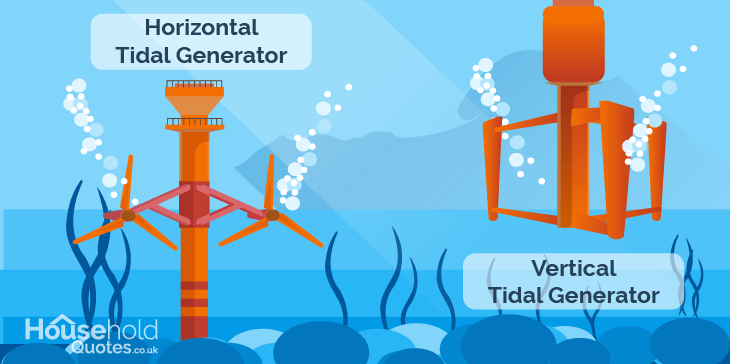- Householdquotes.co.uk
- Wave and Tidal Power
Wave and Tidal Power

The British coastline is 11,072 miles long and has some of the highest tidal ranges in the world. The tidal range in the Severn Estuary that creates the Severn Bore can be as much as 50 feet (15.4 metres), the second highest in the world.
Despite these natural advantages marine renewables are only just developing towards the point where they can be deployed commercially. After testing at the European Marine Energy Centre (EMEC) in Orkney,
Pelamis Wave Power's P1A wave generators have been used to establish a 2.5MW wave farm off the Portuguese coast.
Pelamis have several projects around Europe, and are currently in the first stage of deployment and testing the of the new Pelamis P2 generator.
Tidal Technologies – Tidal Impoundment
The largest tidal power station in the world (and the only one in Europe) is in the Rance estuary in northern France and has been generating 240 MW since 1966. This barrage works like a hydro-electric scheme using the huge volumes of water flowing through the tidal estuary to drive turbines built into the barrage. Particularly on an ebb tide the barrage traps water behind it releasing it slowly as it generates electricity.
Although there are a number of sites in the UK such as the Humber, Dee, Severn and Solway estuaries with enough tidal flow, estuaries are amongst the world’s most productive and sensitive ecosystems, and the flooding by these barrages causes a great disruption to their natural processes. The environmental impact is enormous and projects of this nature struggle for approval.
Tidal Technologies – Submerged Turbines
Alternatively one can use submerged turbines modelled on wind turbine technologies mounted underwater on the sea bed or estuary floor. There are a number of designs some horizontal axis such as Swan Turbines' turbines and some vertical axis such as Blue Energy's turbines.

Because the tidal flow continues unchecked, these technologies have a minimal environmental impact, but being underwater makes installation and maintenance more difficult. However, especially in tidal estuaries the direction of flow is constant so no yawing mechanism is required to align the turbine to the flow.
Wave Technologies
Wave energy generation is still a research field and there are as many designs as companies active in this field. Most are at the concept proving stage and have links to universities such as Plymouth, Manchester and Imperial College. Technologies in development include:
European Marine Energy Centre (EMEC)
EMEC was established to help the evolution of marine energy devices from the prototype stage into the commercial market place and has established full scale testing sites for wave energy sytems at Billia Croo and a testing facility for tidal generators off the island of Eday. To date, Government and other public sector organisations have invested around £15 million in the creation of the centre and its two marine laboratories.
Marine Renewables Deployment Fund
The government has recently set up the £50 million Marine Renewables Deployment Fund to support the continued development of the marine renewables sector. Applications for funding under the Wave and Tidal-stream Energy Demonstration Scheme, part of the MRDF should be submitted to the DTI. Details of this scheme, application forms and submission dates can be found at the DTI website.
Marine Energy Collaboration Fund
In Scotland funding is also available from Scottish Enterprise’s Marine Energy Collaboration Fund. Information and application guidance is available on their website: Scottish Enterprises Marine Energy Collaboration Fund
Severn Barrage
It appears from the governments’ Energy Review 2006 that the Total Impoundment Scheme for the Severn Estuary known as the Severn Barrage will not be supported. It is estimated that this scheme has the potential to supply 5% of current UK electricity needs by 2020 at an estimated construction cost of £14 billion, but the environmental concerns that this project would raise makes it politically unacceptable.
The White Paper published May 2007 and subsequent comments by Peter Hain, Welsh Secretary and First Minister Rhodri Morgan suggest that the government has now decided that Total Impoundment Barrages across the Severn and Cardiff Bay are now in favour.
Household Quotes opposes these schemes based on the potential environmental impact, whilst suggesting that the Severn particularly has such a massive tidal flow that a submerged turbine array would generate as much power with minimal ecological damage. Marine Current Turbines demonstrated this capability with a 300kW single 11m diameter rotor system installed off Lynmouth, Devon in 2003.
